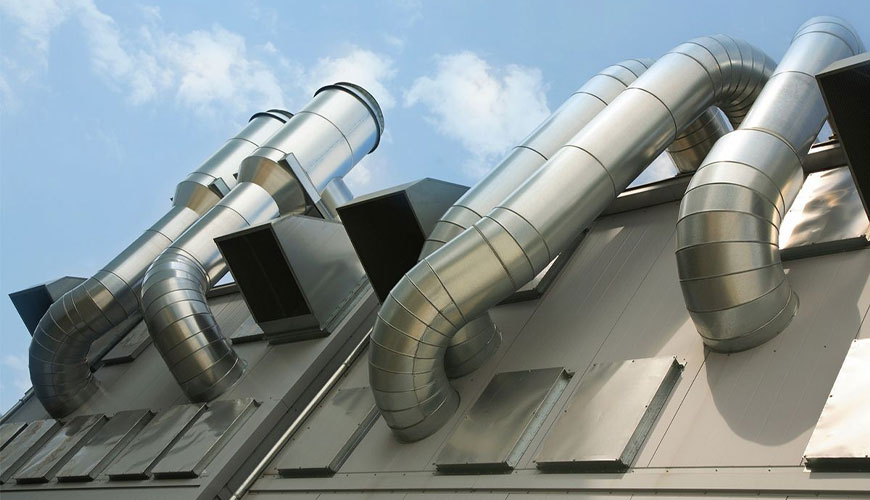

EUROLAB, with its state-of-the-art accredited laboratories and expert team, provides precise and fast testing services within the scope of ISO 16890-1 testing. This standard establishes the efficiency classification system of air filters for general ventilation based on particulate matter (PM).

The effects of particulate matter (PM) on human health have been extensively studied in recent years. The conclusions are that fine dust can be a serious health hazard, contributing to and even causing respiratory and cardiovascular diseases. Different classes of particulate matter can be defined according to the particle size range.
The most important ones are PM 10 , PM 2,5 and PM 1. The US Environmental Protection Agency (EPA), the World Health Organization (WHO), and the European Union define PM 10 as particulate matter passing through a size-selective inlet with a 10% efficiency cutoff at an aerodynamic diameter of 50 µm. PM 2,5 and PM 1 are defined similarly. However, this definition is imprecise if there is no further characterization of the sampling method and the sampling input with a clearly defined separation curve.
In Europe, the reference method for sampling and measuring PM 10 is described in EN 12341. The measuring principle is based on the collection of the PM 10 fraction of the ambient particulate matter in a filter and the gravimetric mass determination.
Because the precise definition of PM 10 , PM 2,5 and PM 1 is quite complex and not easy to measure, public authorities such as the US EPA or the German Federal Environment Agency (Umweltbundesamt) are increasingly using simpler terms in their publications. Particle size fraction of PM 10 less than or equal to 10 µm. The ISO 16890 series refers to this simplified definition of PM 10, PM 2,5 and PM 1, as this deviation from the complex "official" definition mentioned above has no significant effect on the particulate removal efficiency of a filter element.
In the context of the ISO 16890 series, particulate matter defines the size fraction of natural aerosol (liquid and solid particles) suspended in ambient air. The symbol e PM x identifies the effectiveness of an air cleaner against particles with an optical diameter of between 0,3 µm and x µm.
Air filters for general ventilation are widely used in heating, ventilation and air conditioning applications of buildings. In this application, air filters significantly affect indoor air quality and therefore people's health by reducing the concentration of particulate matter.
There is an interest, from international trade and manufacturing, to a well-defined, common test method and to classify air filters according to their particulate efficiencies, particularly with regard to the removal of air filters, to enable design engineers and maintenance personnel to select the correct filter types. particulate matter. Existing regional standards apply completely different testing and classification methods that do not allow comparison with each other and thus hinder global trade with common products.
In addition, current industry standards have known limitations, often producing results that are far from in-service filter performance, i.e. that exaggerate the particulate removal efficiency of many products. With this new ISO 16890 series, a completely new approach has been adopted for a classification system that yields better and more meaningful results than existing standards.
The ISO 16890 series describes equipment, materials, specifications, requirements, qualifications, and procedures for generating laboratory performance data and efficiency classification based on measured fractional efficiency translated into a particulate matter efficiency (e PM) reporting system.
Air filter elements according to the ISO 16890 series are evaluated in the laboratory for their aerosol particle removal capabilities, expressed as efficiency values of e PM 1 , e PM 2,5 and e PM 10. Air filter elements can then be classified according to the procedures described in this section of ISO 16890 .
The particle removal efficiency of the filter element is measured as a function of particle size in the range of 0,3 µm to 10 µm. Unloaded and unconditional filter element according to the procedures defined in ISO 16890-2. After the initial particulate removal efficiency test, the air cleaner element is conditioned according to the procedures defined in ISO 16890-4, and the particle removal efficiency is repeated on the conditioned filter element.
This is done to provide information on the intensity of any electrostatic removal mechanism that may or may not be present in the filter element for testing. The average efficiency of the filter is determined by calculating the average between the initial efficiency and the conditioned efficiency for each size range. The mean efficiency is used to calculate PM x efficiencies by weighting these values against the standardized and normalized particle size distribution of the respective ambient aerosol fraction.
EUROLAB assists manufacturers with ISO 16890-1 test compliance. Our test experts, with their professional working mission and principles, provide you, our manufacturers and suppliers, the best service and controlled testing process in our laboratories. Thanks to these services, businesses receive more effective, high-performance and quality testing services and provide safe, fast and uninterrupted service to their customers.
To get an appointment, to get more detailed information or to request an evaluation, you can ask us to fill in our form and reach you.